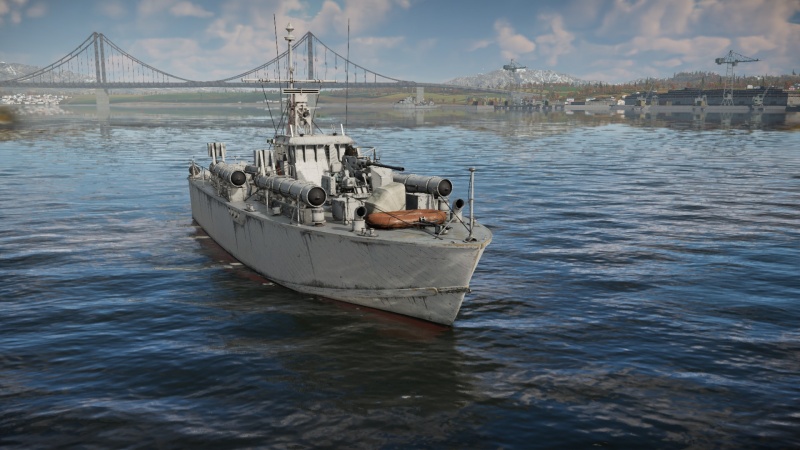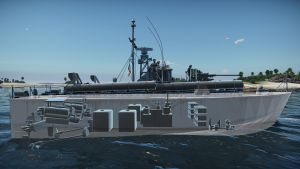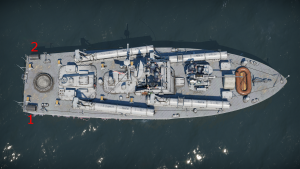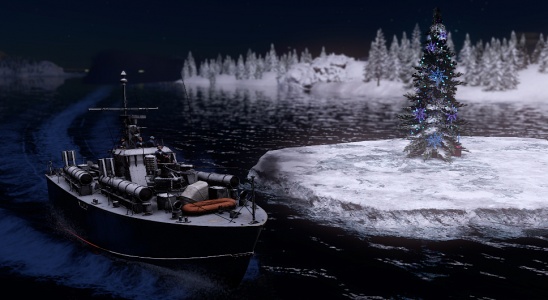Dark Aggressor
| This page is about the British motor gun boat Dark Aggressor. For the Twitch Drop version, see Dark Aggressor TD. |
Contents
Description
The Dark Aggressor (FPB 1102) was a Dark-class fast patrol boat built for the Royal Navy in the mid-1950s. The boats featured alloy framing and wooden decks and skin. 27 were ordered in 1954 but nine were cancelled a year later. The ships featured interchangeable armament which meant they could serve in both motor gun boat and motor torpedo boat roles, depending on their task. They were also the only diesel engine-powered fast patrol boats in the entire Royal Navy. Dark Aggressor was launched on 9th December 1954 and sold on 3rd October 1961.
The Dark Aggressor was introduced in Update 1.83 "Masters of the Sea" as part of the British fleet closed beta test. With the split of the naval tech trees in Update "New Power", Dark Aggressor was moved to the coastal fleet tech tree. Unlike her sister Dark Adventurer which is depicted in the motor gun boat configuration featuring a single 114 mm gun on the bow and 40 mm Bofors autocannon on the stern with no torpedo launchers, the Dark Aggressor is depicted in the motor torpedo boat configuration with four 533 mm torpedo tubes and 40 mm autocannon on the bow.
General info
Survivability and armour
The Dark Aggressor has the following armour layout:
- Hull: 40 mm, wood
- Superstructure: 15 mm, wood
Like most coastal vessels, the Dark Aggressor has no practical armour. The hull and superstructure are unarmoured and will not stop any sort of gunfire.
The hull is split into four hull sections. Starting from the bow and working towards the stern, the first section starts at the bow and ends just in front of the gun; the second ends after the bridge; the third ends where the fuel tanks end, just in front of the engines; and the fourth ends at the stern. Any round with a large enough diameter and explosive mass can hull break the Dark Aggressor. In general, this is limited to HE rounds greater with a diameter greater than or equal to 4 inches (102 mm) and with an explosive mass greater than 1.5 kg. At the Dark Aggressor's battle rating, the only guns that can hull break her are:
- the 10.5 cm SK C/32, found on M-802 and AF D3; and
- the 114 mm 8cwt QF Mk I, found on Dark Adventurer.
There is one ammunition storage located directly underneath the gun turret just above the waterline. Destroying it will instantly destroy the boat.
The Dark Aggressor has a crew complement of 15. With a stock crew, the Dark Aggressor is knocked out when 10 crew are lost; with an aced crew, this is increased to 11. Overall, the survivability is average.
Mobility
| Mobility Characteristics | |||||
|---|---|---|---|---|---|
| Game Mode | Upgrade Status | Maximum Speed (km/h) | Turn Time (s) | Turn Radius (m) | |
| Forward | Reverse | ||||
| AB | Stock | 73 | 27 | ~26.18 | ~50.9 |
| Upgraded | ~17.38 | ~21.25 | |||
| RB/SB | Stock | 64 | 24 | ~29.02 | ~64.2 |
| Upgraded | ~23.83 | ~42.17 | |||
The Dark Aggressor has a displacement of 64 tons.
Modifications and economy
The recommended modification research order is:
- Tool Set
- Fire Protection System
- 40 mm HE clips
- 40 mm AP clips
- Propeller Replacement
- Primary Armament Targeting
- Artillery Support
After that, prioritize the rest of the seakeeping modifications first, then finish researching the remaining modifications in whatever order you prefer.
Armament
Primary armament
The primary armament consists of a single 40 mm QF Mk VII cannon mounted forward with a maximum ammunition load of 1,500 rounds. Stock, the mount can traverse horizontally at a rate of 34°/s and vertically at a rate of 29°/s; with the "Primary Armament Targeting" modification installed, this is increased to 40°/s and 34°/s respectively. The gun has a magazine capacity of 4 rounds and a cycle rate of fire of 160 rounds/min. With a stock crew, it can be reloaded in 0.49 seconds; with an aced crew, this is decreased to 0.38 seconds. The reload is short enough that there is a seamless transition between magazines, although continuously firing for too long will cause the gun to overheat and jam. This happens after continuously firing for about 1.25 min, or about 200 rounds. There is no noticeable drop in accuracy as the gun overheats.
| Primary armament guidance | |
|---|---|
| Horizontal | Vertical |
| ±180° | -10°/+89° |
There are three ammunition types available:
- Universal: AP-T · HEFI-T
- 40 mm HE clips: HEFI-T · HEFI-T · HEFI-T · AP-T
- 40 mm AP clips: AP-T · AP-T · AP-T · HEFI-T
| Penetration statistics | |||||||
|---|---|---|---|---|---|---|---|
| Ammunition | Penetration @ 0° Angle of Attack (mm) | ||||||
| 10 m | 100 m | 500 m | 1,000 m | 1,500 m | 2,000 m | ||
| HEFI-T | 3 | 3 | 3 | 3 | 3 | 3 | |
| AP-T | 81 | 78 | 68 | 58 | 49 | 41 | |
| Shell details | ||||||||||||
|---|---|---|---|---|---|---|---|---|---|---|---|---|
| Ammunition | Velocity (m/s) |
Projectile mass (kg) |
Fuse delay (m) |
Fuse sensitivity (mm) |
Explosive mass (TNT equivalent) (g) |
Ricochet | ||||||
| 0% | 50% | 100% | ||||||||||
| HEFI-T | 874 | 0.9 | 0 | 0.1 | 67.13 | 79° | 80° | 81° | ||||
| AP-T | 874 | 0.89 | - | - | - | 47° | 60° | 65° | ||||
The best ammunition is the 40 mm HE clips because it has the highest ratio of HE rounds to AP rounds. Take mostly 40 mm HE clips along with several 40 mm AP clips for armoured targets. Because of the gun's seamless reload, there is no reason to use the Universal belt once the others are unlocked.
Additional armament
The Dark Aggressor has two possible loadouts:
- 4 x Mk.VIII torpedo
- 2 x Mk.VII depth charge
- 4 x Mk.VIII torpedo; 2 x Mk.VII depth charge
- Without load
Torpedoes
The Dark Aggressor can carry four 533 mm Mk.VIII torpedoes. The torpedo tubes are located on either side of the bridge, pointing forwards with the nose angled outwards.
| Torpedo characteristics | ||||||||
|---|---|---|---|---|---|---|---|---|
| Torpedo Mode | Mass (kg) | Maximum speed in water (km/h) | Travel distance (km) | Depth stroke (m) | Arming distance (m) | Explosive type | Explosive mass (kg) | TNT equivalent (kg) |
| No | 1,566 | 84 | 4.57 | 1 | 50 | TNT | 327 | 327 |
| Yes | 1,566 | 76 | 6.40 | 1 | 50 | TNT | 327 | 327 |
The Torpedo Mode modification is available as a rank IV modification. Installing it will give the following changes:
| Torpedo mode specification changes | |
|---|---|
| Max Distance (m) | Max Speed (m/s) |
| +1,830 | -2 |
It's best to always keep Torpedo Mode uninstalled. The maximum speed of a torpedo is much more valuable in coastal battles than its maximum range. Coastal fleet maps are also small enough that the decreased range with Torpedo Mode installed isn't much of an issue.
In RB, always set the depth stroke to the minimum 1 m setting. This is because many vessels that the Dark Aggressor can face will not have a deep enough draught to fuse the torpedo at a depth stroke setting of 4 m. In AB, depth stroke is automatically set to the most optimal setting.
When using torpedoes, be aware that unless they are already launched, the torpedoes have a very high chance to detonate when shot at, instantly destroying the boat. To avoid this, fire the torpedoes immediately after spawning in—as well as after any subsequent reloads in AB—or simply don't take them at all. Torpedoes are a situational weapon, so it's largely down to personal preference whether or not to take them.
Depth charges
The Mk.VII depth charges are carried on the stern, one on each side. They are dropped one at a time in the following order:
- Starboard
- Port
Before spawning, the detonation time delay can be set anywhere between 3 seconds and 10 seconds.
| Depth charge characteristics | ||||||
|---|---|---|---|---|---|---|
| Mass (kg) | Explosive type | Explosive mass (kg) | TNT equivalent (kg) | HE armour penetration (mm) | Armoured vehicle destruction radius (m) | Fragment dispersion radius (m) |
| 196 | TNT | 130 | 130 | 101 | 8 | 122 |
There is almost no practical reason to use depth charges on any naval vessel in the game. Although they usually result in a one-hit kill if used properly, they are extremely situational, requiring the player to close to point-blank ranges to even use them. In almost every case, anytime a depth charge could be used, the guns or torpedoes can be used instead to greater effect. In fact, depth charges tend to actually be a liability in battle, since they essentially act as exposed ammo racks before they're dropped. Like torpedoes, they can be shot at, and if destroyed, they have a chance to detonate, instantly destroying the boat.
Despite this, some success can be had in dropping them either next to, or in front of a large, slow target. If dropping them next to the target, remember the depth charge drop order, since it's most likely that only the depth charges dropped on the side closest to the enemy will deal any damage. If dropping in front of the target, rush in from the sides as quickly as possible and drop them all at once directly in front of the target. For both cases, set the depth charge time delay to the minimum 3 seconds, since any higher time delay will only allow the depth charge to sink further away from the target, giving them more time to move out of the way. Again, using depth charges is extremely situational, and they will only be a liability the vast majority of the time, so take them at your own discretion.
Usage in battles
Compared to the sister gunboat Dark Adventurer, the Dark Aggressor is a traditional PT boats and plays like one, with some slight caveat. The boat features four powerful torpedoes and frontal-mounted Bofors autocannons in exchange of the 114 mm cannons. Due to the lack of rear coverage, however, the boat is highly vulnerable against flankers or enemy aircraft approaching the stern. Because of this, let your bow face the enemy as much as possible to minimize the chance of ammo rack detonation.
As the Bofors have a higher effective range than most of the ~20 mm autocannons that were quite common at this BR, the Dark Aggressor can also be used to provide fire support at longer ranges (~2.5 km) and outrange most of the PT boats. As the Bofors can seamlessly switch between each ammo belt, the AP belt is recommended for long range engagements, though the "Universal" belt can also do its job quite well at range.
Pros and cons
Pros:
- Features a frontal-mounted Bofors autocannons with good frontal coverage
- 40 mm Bofors offer great damage output against surface and aerial targets
- Fast and manoeuvrable
- Armed with four torpedoes with good speed and filler
Cons:
- Mediocre survivability, especially from the sides
- Somewhat tall, unarmoured hull profile with a highly vulnerable ammo racks
- Main armament is easily knocked out
- No secondary or anti-aircraft armament, the stern is effectively a huge blind spot
History
The Dark-class fast patrol boats, also known as the Admiralty Type "A" Fast Patrol Boat (FPB), were 18 patrol boats used by the Royal Navy, with another 8 built for export. The class was originally ordered in the late 1940s, calling for a new diesel-powered FPB, with Saunders-Roe eventually winning the design contract in early 1952. The Dark class was built between 1954 and 1958 primarily by Saunders-Roe alongside several other British shipbuilding companies. The Dark class had interchangeable armaments and could be configured as motor torpedo boats, as motor gun boats, or as minelayers. These armaments include:
- 4 x 21-inch torpedoes
- 1 x 40 mm Bofors gun (forward), 2 x 21-inch torpedoes
- 1 x 40 mm Bofors gun (aft), 1 x 4.5-inch cannon (forward)
- 16 x mines
The Dark class boats had a length of 71 ft. 8 in., a beam of 19 ft. 5 in., a draught of 6 ft. 1 in, and a standard displacement of 50 long tons and were the first of their kind in Royal Navy service to use diesel engines. Each boat was powered by two 18 cylinder Napier Deltic diesel engines, each producing 2,500 bhp and driving a single shaft, with an exhaust port on the port side hull. The first few Dark class boats were painted entirely in standard grey. However, the port side of the hulls would quickly become stained by the diesel exhaust fumes, even after only a short period of use. Initially, an experimental paint scheme was tried on HMS Dark Biter (P1104) around March 1956 that had the rear hull painted in black with the front hull still in grey. This, too, was found to be unsatisfactory, and eventually, it was decided that the entire hull of the Dark class boats was to be painted in black.
Eighteen Dark class boats served with the Royal Navy. All of these were built with wooden hulls and aluminium decks on aluminium hull frames with the exception of the final boat, the unique HMS Dark Scout (P1116), which had an all-aluminium welded construction, a redesigned bridge, and transom exhaust ports. In addition to these, eight more Dark class boats were also built for export, all built by Saunders-Roe: two standard boats to Finland; five riveted, all-aluminium boats with an additional electric drive system to Burma; and one standard boat to Japan. A further nine Dark class boats were planned to be built as well for Royal Navy service, but these were all cancelled in 1955. During the 1960s and 1970s, of the 18 Dark class boats in Royal Navy service, two were used as target practice with one being sunk. The surviving 17 were sold to various places, including several to Italian law enforcement in the late 1960s.
HMS Dark Adventurer, pennant number P1101, was the first of the Dark-class boats. She was built by Saunders-Roe in Beaumaris and was completed on 28th October 1954. She was sold in early 1970.
Media
- Skins
- Images
Dark Aggressor wallpaper, from [Event] Festive events!.
See also
External links
- [Coastal Forces Veterans Forum] The British "Dark" Class
- [Coastal Forces Veterans] Boat Database
- [British Military Powerboat Team] Dark Class Boats
- [mprints.co.uk] SARO Dark Class MTBs
- [Coastal Forces Veterans] Boat Database
| Saunders-Roe Limited | |
|---|---|
| Fast Patrol Boats | |
| Dark-class | Dark Adventurer · Dark Aggressor |
| Britain boats | |
|---|---|
| Motor torpedo boats | Brave Borderer · Dark Aggressor · Dark Aggressor TD · Fairmile D (617) · Fairmile D (697) · Fairmile D (5001) · HMS Gay Archer |
| MTB-1(1) · MTB-1(2) · MTB Vosper · MTB Vosper(2) · MTB-422 | |
| Motor gun boats | Dark Adventurer · Fairmile A (ML100) · Fairmile B (ML345) · Fairmile C (312) · Fairmile C (332) · Fairmile D (601) · Fairmile H LCS(L)(2) |
| HMAS Arrow · HMAS Fremantle · MGB-61 · MGB-75 · ML 1383 · SGB Grey Fox · SGB Grey Goose | |
| Gunboats | HMS Spey |








